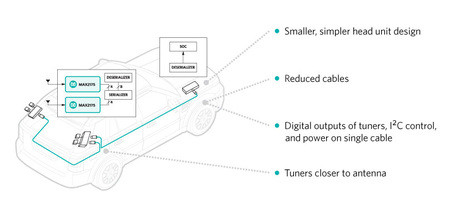Revisiting radio tuners in car head units
January 24, 2017

Advanced driver assistance system (ADAS) features are taking over the head unit in cars, and that inevitably requires more space and power. So how can...
Advanced driver assistance system (ADAS) features are taking over the head unit in cars, and that inevitably requires more space and power. So how can car OEMs take things out of the head unit and move in more ADAS functions?
Automotive chipmaker Maxim Integrated has an idea. It entails replacing multiple radio tuner circuits inside the head unit with a single tuner located near the antenna, and then linking the tuner to the main host processor in the head unit to perform baseband tasks.
In a traditional architecture, multiple radio tuner front ends are connected to the head unit via analog cables, which are inherently susceptible to noise and heat dissipation while transporting signals from antenna to head unit. Additionally, each tuner requires its own baseband hardware.
What Maxim brings to the table is a remote tuner solution that is positioned near the antenna to free up space in the head unit (Figure 1). It digitizes tuner outputs for transmission to the head unit over a single coaxial cable that carries both radio signals and power. The result is lower thermal overhead, less noise, and reduced cable weight and cost.
The key building block in this remote tuner solution is the MAX2175 analog/digital hybrid radio receiver IC that unifies hardware for multiple radio broadcast standards like AM, FM, DMB, etc. It serializes the signals using the Maxim’s 14-bit GMSL SerDes pair and sends them to the head unit over a low-cost coaxial cable.
Digital, as opposed to analog, signals are less prone to noise and heat dissipation. Maxim’s RF to Bits tuner also allows baseband processing to be carried out in software within the main head unit SoC, which eliminates the need for a separate baseband processor (Figure 2).
William Chu, managing director of automotive at Maxim, says that a single piece of hardware for all radio standards allows car manufacturers to simplify head unit design and lower power consumption. “Just one digital cable instead of four analog cables also lowers the cost and weight and improves radio performance,” Chu says.
Moreover, to facilitate a software-defined radio (SDR) approach to baseband processing, Maxim, in collaboration with Munich-based digital audio specialist Fraunhofer IIS, is making core development kits (CDKs) available to automotive engineers. For its part, Fraunhofer IIS claims to have developed a complete SDR solution for Maxim’s infotainment hardware.







